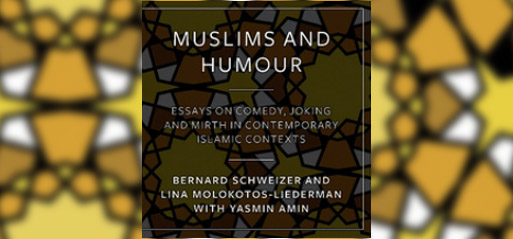
Muslims and Humour – Essays on Comedy, Joking and Mirth in Contemporary Islamic Contexts. Edited by Bernard Schweizer and Lina Molokotos–Liederman with Yasmin Amin. Pages 283. 2022. HB. £85. Bristol University Press.
In the prayer that I would find a book on funny Muslim anecdotes or even better, a knock-knock joke book for Muslim adults, I picked up the book, hoping the title would reflect the content. Not this one. Putting my disappointments aside, this book makes a valuable scholarly contribution to the role that humour plays in faith and its practiCes and uses humour as a political tool to speak truth in places of power.
For example, there was a narration of a companion of the Prophet by the name of Adi b Hatim who, in an attempt to shorten the length of his fast, said, “When the verse ‘Eat and drink until the twilight enables you to distinguish between a white and black thread’ (Qur’an 2:187) was revealed, I took a white and black thread and held them under my pillow, so when I looked at them, I could not distinguish them from each other. When I mentioned this to the Prophet, God bless him and grant him peace, he laughed.” (p56)
This idea that our Blessed Prophet had the capacity to laugh at his companions’ antics to bypass the laws of God, I find oddly very reassuring. I sometimes think that in our quest to create an image of the Prophet that is divine, we have misunderstood what made him so dear to the people around him. It wasn’t his severity or austere dedication to the laws of God.
It was his ability to laugh and accept our shortcomings and still feel worthy of the love of the Divine that was channelled through our Prophet Muhammad (Peace be upon him), and surely there lies an example for all of us to follow.
In our times of increased polarisation, a form of faith that encourages hilarity even when the divine laws are being broken can heal divides rather than entrench those differences amongst us.
The book also touched upon the use of humour in televised shows to target people and places of power. What they pointed out was that when humour was used to speak to target groups of individuals in power collectively, it was acceptable, but the moment it became personal and singled out individuals, it became unacceptable.
“Jokes should not target people on a personal basis and encroach upon their dignity and humanity. Rather, the joke empowers the silent majority and gives it a podium, a pedestal, from which to vent its anger and frustration, not only via social media but also through traditional TV and theatrical performances.” (p188)
So, the authors give contemporary instances where Sayyed Nasrallah of Hizbollah was ridiculed alongside the Sunni Mufti and the Maronite Cardinal; it was considered acceptable, but the moment Syed Nasrallah was ridiculed on his own by Charbil Khalil, producer of Basmat Watan, there were retaliatory measures put into place.
Although there is an acceptance of ‘resistance art forms’ codified within practices of faith, using humorous art forms to show resistance against religious figureheads has not been accepted but stands as an important tool to voice discontent with political and religious leaders.
This book was a dense read but offered a lot about the intersection of faith and humour. From diving into the perceptions of the Prophet laughing to Muslim stand-up comedians in North America and the role they play in bridging gaps of understanding in increasingly polarised societies.
But my biggest nugget of understanding I got was how humour is used as a tool of resistance, giving voices to the often unheard, and how spaces that allow for humour can have the ability to build bridges, and we could use more of those in our world today.
Aasiya I Versi